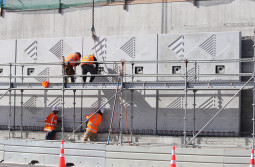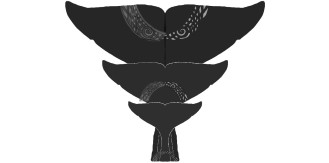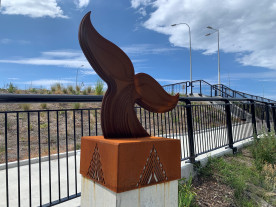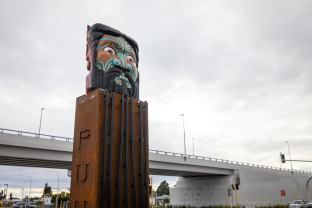- The way people used the corridor
- Mahi toi – artistic elements
- Anei ngā ringatoi – here are our artists
- Te Horoipia bridge
The Bay Link project will include a number of carvings, sculptures and pou whenua designed to reflect the values and historical significance of the area. These are being developed in partnership with the Bay Link Tangata Whenua Advisory Group.
In the past, the Bay Link corridor was part of a broader route Ngāi Te Rangi iwi used to travel east and return for various purposes such as trading goods, seasonal harvesting, sourcing food, visiting whānau and attend gatherings. To this day, people travel the corridor for similar reasons.
He ara tēnei nō ō mātou tūpuna i ngā wā o te riri kia whakangungu i tō rātou whenua. He wāhi okiokinga hoki kia horoi ō rātou pia.
This is the pathway where our ancestors travelled in times of war in defence of the land. And also a resting place for the washing of their weapons.
Recognising the cultural identity and values of mana whenua, and acknowledging and expressing their traditions and relationships with their ancestral lands, water, sites, wāhi tapu and other taonga is an integral part of the project. To share and connect people with the rich cultural history throughout the Bay Link construction area, we are working with local mana whenua representatives from Ngā Pōtiki, Ngāi Tukairangi and Ngāti Tapu.
The way people used the corridor
The overall cultural narrative of “a travel corridor – a place of passage and movement and pathways” is formed through a series of sub-narratives; the five key movement patterns and reasons why the surrounding area has historically been a travel corridor and place of passage and movement.
These narratives are applied at different scales and locations to reflect the rich and layered history of the area.
These five key movement patterns were around:
- Food bowl/source of food
- Strategic locations for settlement due to ecology
- For battle/conflicts
- For trade/swapping of goods
- Whanau/family and gatherings
The Bay Link project represents more than a roading infrastructure upgrade for local mana whenua. A transformational project like Bay Link inevitably alters the whenua (land); changing its function, its use, and its story.
In designing this new landscape, a unique opportunity arises: to use the infrastructure as a lens – a canvas, to capture and share the stories and history tapu (sacred) to mana whenua and reconnect the people of Tauranga Moana and visitors alike with this place – this whenua.
Mahi toi – artistic elements
A series of unique yet connected mahi toi are being developed as part of the Bay Link project. Each uses the talent, craft and traditional knowledge held by Tauranga Moana multidisciplinary artists Linda Munn, Maraea Timutimu and Stu McDonald who are of this whenua and know the stories it has to tell.
The works are being developed through an iterative process with advisory group members, artists and the broader project team. The tangata whenua working group meet monthly to discuss construction updates, community concerns, urban and landscape design updates to ensure all elements of the project, including cultural considerations are progressing with integrity.
This rewarding process of collaboration has resulted in a number of carvings, sculptures, pou whenua and markers, designed to reflect the values and historical significance of the area. These elements will begin to be unveiled as construction progresses.
Mahi toi
Anei ngā ringatoi – here are our artists

L to r: Maraea Timutimu, Stu McDonald, Linda Munn.
Maraea Timutimu – Ngāi Te Rangi, Ngāti Ranginui, Ngāi Tūhoe
Maraea is a visual artist and teacher whose portfolio spans a range of mediums and platforms. She has had numerous pieces in prominent art exhibitions across Aotearoa, with a practice backed by years of practical, theoretical, and experimental knowledge. Maraea emphasises the importance of Te Ao Māori (Māori world view) in her mahi, expertly weaving whakapapa, process and meaning in all her mahi toi.
Stu McDonald – Ngā Rauru, Ngāti Ranginui, Ngāi Te Rangi, Ngati Rehua, Ngāti Tapu
Stu is a tā moko (traditional Māori tattoo) artist, teacher and carver by study and trade. He has a prominent local Tauranga Moana based studio – The Ahipoutu Collective, and a team of creatives around him creating beautiful pieces for people and places around Aotearoa and internationally. Stu also shares his knowledge in education, mental health and wellbeing working with local schools in Tauranga Moana and the broader Bay of Plenty.
Stu’s traditional knowledge of tā moko and whakairo (carving), and general skill as a creative and artist, has led to a broad range of project experience, with the Bay Link project providing a great opportunity to work with different scales and mediums.
Linda Munn – Ngāpuhi, Ngāi Te Rangi, Ngā Pōtiki, Te Āti Awa, Ngāi Tahu
Linda’s multidisciplinary art practice reinforces principles of tino rangatiratanga (Māori self-determination). She uses ancestral knowledge to explore the metaphysical and the place of spirituality in Māori cultural life. In 1989, with Hiraina Marsden and Jan Dobson, she designed the Tino Rangatiratanga flag as a way of unifying Māori concerns about the 1990 celebrations commemorating 150 years of Māori and Pākehā relations. Today, the Tino Rangatiratanga flag is mandated as the national Māori flag and is a symbol of Māori resistance and resilience.
Te Horoipia bridge
Te Horoipia Bridge (Bayfair flyover) has been gifted its name by mana whenua to reflect the cultural history and landscape in which it sits. Horoipia is the name of an ancient waterway of this area, which means ‘the washing of the spears’. There were many puna-wai (freshwater springs) throughout this area which were used by the toa (warriors) to purify and cleanse their taiaha (weapons) after battle.
It was also used as an urupā – the warriors would often stop and bury tūpāpaku in the swamp areas. Te Horoipia area is located between Ohuki and the sea, situated between Omanu to the west and Wharawhara to the east. This place is of great historical significance and considered wāhi tapu (sacred).






